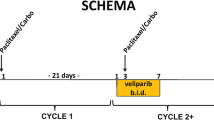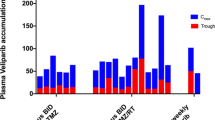Summary
Temozolomide (TMZ) generates DNA adducts that are repaired by direct DNA and base excision repair mechanisms. Methoxyamine (MX, TRC-102) potentiates TMZ activity by binding to apurinic and apyrimidinic (AP) sites after removal of N3-methyladenine and N7-methylguanine, inhibiting site recognition of AP endonuclease. We conducted a phase I trial to determine the maximum tolerated dose and dose-limiting toxicities (DLTs) of intravenous MX when given with oral TMZ. Patients with advanced solid tumors and progression on standard treatment were enrolled to a standard 3 + 3 dose escalation trial assessing escalating doses of TMZ and MX. Tumor response was assessed per RECIST and adverse events (AEs) by CTCAEv3. Pharmacokinetics (PK) of MX and COMET assays on peripheral blood mononuclear cells were performed. 38 patients were enrolled—median age 59.5 years (38–76), mean number of cycles 2.9 [1–13]. No DLTs were observed. Cycle 1 grade 3 AEs included fatigue, lymphopenia, anemia, INR, leukopenia, neutropenia, allergic reaction, constipation, psychosis and paranoia. Cycle 2–13 grade 4 AEs included thrombocytopenia and confusion. A partial response was seen in 1 patient with a pancreatic neuroendocrine tumor (PNET) and six additional patients, each with different tumor types, demonstrated prolonged stable disease. MX PK was linear with dose and was not affected by concomitant TMZ. TMZ 200 mg/m2 daily × 5 may be safely administered with MX 150 mg/m2 intravenously once on day 1 with minimal toxicity. Further studies assessing this drug combination in select tumor types where temozolomide has activity may be warranted.





Similar content being viewed by others
References
National Comprehensive Cancer Network (NCCN) Clinical Practice Guidelines in Oncology (NCCN guidelines). Central Nervous System Cancers, version 1.2016
National Comprehensive Cancer Network (NCCN) Clinical Practice Guidelines in Oncology (NCCN guidelines). Melanoma, version 3.2016
National Comprehensive Cancer Network (NCCN) Clinical Practice Guidelines in Oncology (NCCN guidelines). Neuroendocrine Tumors, version 2.2016
Wang Y, Liu L, Wu C, Bulgar A, Somoza E, Zhu W, Gerson SL (2009) Direct detection and quantification of abasic sites for in vivo studies of DNA damage and repair. Nucl Med Biol 36:975–983
Curtin NJ (2012) DNA repair dysregulation from cancer driver to therapeutic target. Nat Rev Cancer 12:801–817
Yan L, Bulgar A, Miao Y, Mahajan V, Donze JR, Gerson SL, Liu L (2007) Combined treatment with temozolomide and methoxyamine: blocking apurinic/pyrimidinic site repair coupled with targeting topoisomerase IIα. Clin Cancer Res 13:1532–1539
Bulgar AD, Weeks LD, Miao Y, Yang S, Xu Y, Guo C, Markowitz S, Oleinick N, Gerson SL, Liu L (2012) Removal of uracil by uracil DNA glycosylase limits pemetrexed cytotoxicity: overriding the limit with methoxyamine to inhibit base excision repair. Cell Death Dis 12:e252. https://doi.org/10.1038/cddis.2011.135
Bulgar AD, Snell M, Donze JR, Kirkland EB, Li L, Yang S, Xu Y, Gerson SL, Liu L (2010) Targeting base excision repair suggests a new therapeutic strategy of fludarabine for the treatment of chronic lymphocytic leukemia. Leukemia 24:1795–1799
Liu L, Bulgar A, Donze J, Adams BJ, Theuer CP, Gerson SL (2007) Prevention of base excision repair by TRC102 (methoxyamine) potentiates the anti-tumor activity of pemetrexed in vitro and in vivo. J Clin Oncol 25(suppl: abst 12005)
Taverna P, Liu L, Hwang HS, Hanson AJ, Kinsella TJ, Gerson SL (2001) Methoxyamine potentiates DNA single strand breaks and double strand breaks induced by temozolomide in colon cancer cells. Mutat Res 485:269–281
Liu L, Nakatsuru Y, Gerson SL (2002) Base excision repair as a therapeutic target in colon cancer. Clin Cancer Res 8:2985–2991
Gordon MS, Rosen LS, Mendelson D, Ramanathan RK, Goldman J, Liu L, Xu Y, Gerson SL, Anthony SP, Figg WD, Spencer S, Adams BJ, Theuer CP, Leigh BR, Weiss GJ (2013) A phase 1 study of TRC-102, an inhibitor of base excision repair, and pemetrexed in patients with advanced solid tumors. Investig New Drugs 31:714–723
Caimi P, Cooper B, William BM, Campagnaro EL, Creger RJ, Afable M, Xu Y, Pink J, Dowlati A, Lazarus HM, de Lima M, Gerson SL (2014) Phase I trial of the base-excision repair blocker methoxyamine (TRC-102) combined with fludarabine in relapsed/refractory chronic lymphocytic leukemia (CLL) and lymphoid malignancies. Blood 124:4688
Yang S, Savvides P, Liu L, Gerson SL, Xu Y (2012) Development and validation of an LC-MS/MS method for pharmacokinetic study of methoxyamine in phase I clinical trial. J Chromoatogr B Analyt Technol Biomed Life Sci 901:25–33
Singh NP, McCoy MT, Tice RR, Schneider EL (1988) A simple technique for quantitation of low levels of DNA damage in individual cells. Exp Cell Res 175:184–191
Tice RR, Agurell E, Anderson D, Burlinson B, Hartmann A, Kobayashi H, Miyamae Y, Rojas E, Ryu JC, Sasaki YF (2000) The single cell/gel comet assay: guidelines for in vitro and in vivo genetic toxicology testing. Environ Mol Mutagen 35:206–221
Komet User Guide, Kinetic Imaging. June 2005, version 6.0.1
Therasse P, Arbuck SG, Eisenhauer EA, Wanders J, Kaplan RS, Rubinstein L, Verweij J, van Glabbeke M, van Oosterom AT, Christian MC, Gwyther SG (2000) New guidelines to evaluate the response to treatment in solid tumors. J Natl Cancer Inst 92:205–216
Meehan RS, Chen AP, O’Sullivan Coyne GH, Collins JM, Kummar S, Anderson L et al (2016) A phase 1 trial of TRC102 (methoxyamine HCl) with temozolomide (TMZ) in patients with solid tumors and lymphomas. J Clin Oncol 34(suppl; abstr 2556)
Condie AG, Yan Y, Gerson SL, Wang Y (2015) A fluorescent probe to measure DNA damage and repair. PLoS One 10:e0131330. https://doi.org/10.1371/journal.pone.0131330
Chan JA, Stuart K, Earle CC, Clark JW, Bhargava P, Miksad R, Blaszkowsky L, Enzinger PC, Meyerhardt JA, Zheng H, Fuchs CS, Kulke MH (2012) Prospective study of bevacizumab plus temozolomide in patients with advanced neuroendocrine tumor. J Clin Oncol 30:2963–2968
Kulke MH, Stuart K, Enzinger PC, Ryan DP, Clark JW, Muzikansky A, Vincitore M, Michelini A, Fuchs CS (2006) Phase II study of temozolomide and thalidomide in patients with metastatic neuroendocrine tumors. J Clin Oncol 24:401–406
Strosberg JR, Fine RL, Choi J, Nasir A, Coppola D, Chen DT, Helm J, Kvols L (2011) First-line chemotherapy with capecitabine and temozolomide in patients with metastatic pancreatic endocrine carcinomas. Cancer 117:268–275
Funding
This project was supported NCI grants R21 CA126149 and 5R01 CA86357 and by the Case Comprehensive Cancer Center (CCCC) (P30CA043703), the Translational Research and Pharmacology Core Facility of the CCCC, the UPMC Hillman Cancer Center Cancer Pharmacokinetics and Pharmacodynamics Facility (CPPF) and the following awards—P30CA47904, 5K12CA076917–17.
Author information
Authors and Affiliations
Corresponding author
Ethics declarations
Conflict of interest
Jennifer Eads reports no conflict of interest.
Smitha S. Krishnamurthi reports no conflict of interest.
Joel Saltzman reports no conflict of interest.
Joseph A. Bokar reports no conflict of interest.
Panos Savvides reports no conflict of interest.
Neal J. Meropol is an employee of Flatiron Health, Inc., an independent subsidiary of the Roche Group. NJM holds equity interest in Flatiron Health and Roche.
Joseph Gibbons reports no conflict of interest.
Henry Koon is an employee of Bristol Myers Squibb.
Neelesh Sharma is an employee of Novartis.
Lisa Rogers reports no conflict of interest.
John J. Pink reports no conflict of interest.
Yan Xu reports no conflict of interest.
Jan H. Beumer reports no conflict of interest.
John Riendeau reports no conflict of interest.
Pingfu Fu reports no conflict of interest.
Stanton L. Gerson is inventor of a patent on methoxyamine. The intellectual property on methoxyamine has been licensed by Case Western Reserve University to Tracon Pharmaceuticals, Inc., and Dr. Gerson owns stock in, and is a paid consultant for Tracon Pharmaceuticals, Inc.
Afshin Dowlati reports research support (to institution) by Ipsen, Tesaro, Takeda, Astra Zeneca, Bayer, Eli-Lilly, Abbvie, Seattle Genetics, Bristol Myers-Squibb, Regeneron, Amgen, Symphogen. Dr. Dowlati reports advisory role for Seattle Genetics, Takeda, Abbvie, Bristol Myers-Squibb and Astra Zeneca.
Ethical approval
All procedures performed in studies involving human participants were in accordance with the ethical standards of the institutional research committee and with the 1964 Helsinki declaration and its later amendments or comparable ethical standards.
Informed consent
Informed consent was obtained from all individual participants included in the study.
Additional information
Publisher’s note
Springer Nature remains neutral with regard to jurisdictional claims in published maps and institutional affiliations.
Appendix
Appendix
Rights and permissions
About this article
Cite this article
Eads, J.R., Krishnamurthi, S.S., Saltzman, J. et al. Phase I clinical trial of temozolomide and methoxyamine (TRC-102), an inhibitor of base excision repair, in patients with advanced solid tumors. Invest New Drugs 39, 142–151 (2021). https://doi.org/10.1007/s10637-020-00962-x
Received:
Accepted:
Published:
Issue Date:
DOI: https://doi.org/10.1007/s10637-020-00962-x




